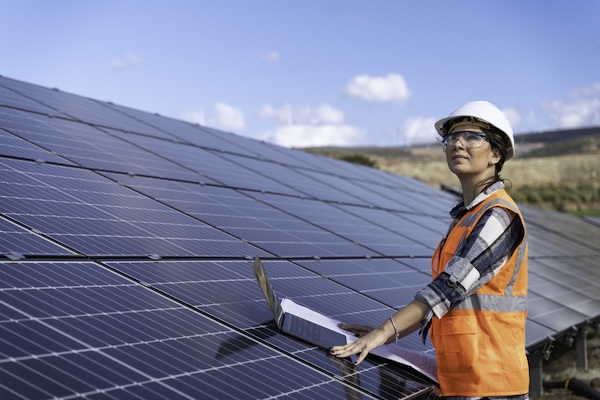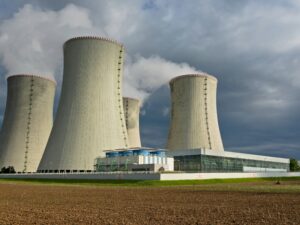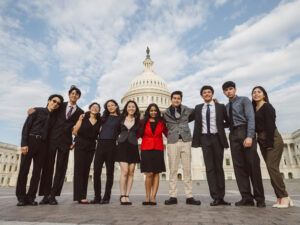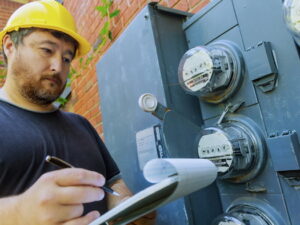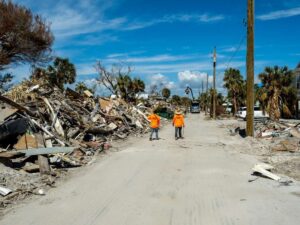The clean energy economy is here
by Elissa Tennant
The clean energy economy is here, baby, and we’re rolling out the welcome mat. Despite a series of rollbacks under the current administration, this tidal wave can’t be stopped. We’re still seeing a transition to cleaner energy sources in real time that will help us address climate change while remaining competitive with other global superpowers.
This shift toward cleaner energy comes right on time. Americans are facing extreme weather events, like heatwaves and wildfires, exacerbated by a changing climate. We’re also facing a home insurance crisis and rapidly rising electricity bills. Transitioning our energy sources is not only crucial for addressing climate change, it’s a massive economic opportunity.
What is the clean energy economy?
A clean energy economy makes use of renewable energy sources to reduce emissions and boost economic growth. Countries that make a significant investment in clean energy infrastructure are better poised to compete in a global market. Domestically, these countries may also see an increase in job opportunities and cheaper power sources for citizens.
There are many sources of clean energy that make up our energy mix, each of which has its pros and cons. Examples include:
- Solar power: Converts energy from the sun into electricity.
- Wind energy: Converts kinetic energy from blowing winds into electricity.
- Nuclear power: Converts energy from nuclear reactions into electricity.
- Geothermal energy: Converts energy from the Earth’s natural heat into power sources.
- Hydropower energy: Converts kinetic energy from naturally moving water sources into electricity.
- Battery storage: Investment in devices that allow for power generated by the above sources to be stored and used later.
Clean energy setbacks
The United States’ biggest investment in clean energy came in the form of the Inflation Reduction Act of 2022 (IRA). Over its tenure, the IRA spurred hundreds of billions of dollars in clean energy investments and a rapid deployment of projects like solar farms and battery storage facilities.

U.S. clean power generation capacity additions, showing big growth in solar and battery projects since the IRA was passed. Source: American Clean Power
According to an analysis from CCL’s Research Manager, Dana Nuccitelli, investments from the IRA will save about 1 billion tons of carbon dioxide pollution over the next decade. That’s equivalent to permanently shutting down 26 coal power plants, or taking 23 million cars off the road.
Though the One Big Beautiful Bill Act, signed into law July 4, 2025, has ended many clean energy incentives early, it didn’t completely end investments. The administration still supports funding for certain technologies with bipartisan interest, like geothermal and nuclear. The clean energy economy is here, and it doesn’t appear to be making a grand exit any time soon.
How clean energy boosts the U.S. economy
There are several ways in which clean energy investments support a healthy economy:
Job creation
In 2024, a Department of Energy report found that clean energy jobs grew at more than twice the rate of overall employment. In many areas, clean energy jobs have outpaced fossil fuel-related jobs, especially under the IRA. Currently, the five states with the most energy efficient jobs are:
- California (302,176)
- Texas (172,917)
- New York (129,946)
- Florida (125,234)
- Illinois (86,728)
Notably, clean energy requires equipment, including solar panels, wind turbines, batteries, and EV components. The opportunity to fuel the clean energy economy by making these parts in the U.S. provides new manufacturing jobs.
Community development
Clean energy projects are revitalizing communities across the country. The IRA included a landmark Greenhouse Gas Reduction Fund, administered by the EPA, that provided billions in grants for clean energy investments with an emphasis on revitalizing communities “that have historically been left behind.” This funding has since been revoked, but agencies like the Department of Energy and United States Department of Agriculture continue to work with local communities, and especially urban farmers, to spur clean energy investments like solar panels in otherwise unused stretches of land.
Lower energy costs
Without home and building efficiency, air conditioning runs overtime and causes electricity bills to skyrocket. Inflation and regional utility price hikes also contribute to this issue. Switching to cleaner sources of energy provides long-term affordability, giving consumers money back in their pockets.
Energy security & independence
When we continue to invest in oil, we continue to rely on volatile foreign oil markets, subject to shortages, price hikes, and any number of political issues. By investing in clean energy sources domestically, we increase our energy independence. We also promote energy security, reducing the prevalence of power outages and even widespread crises like the Great Texas Freeze.
Climate and public health benefits
The clean energy economy doesn’t just support America’s national wallet. It makes major dents in harmful carbon emissions that fuel climate change.
Switching to clean energy reduces pollution in the air we breathe. It also lowers the risk of harm from heat waves and provides more resilient infrastructure to withstand extreme weather events.
For example: Fossil fuels tend to intensify the urban heat island effect, which states that cities tend to be slightly warmer than surrounding areas. As cities crank their A/C, energy bills rise and residents are subject to peak price hikes and grid failures as fossil fuel-based systems scramble to keep up.
Renewable energy helps decrease the need for polluting peak energy sources during heat waves. Solar panels and energy storage also improve local grid reliability during climate extremes. If we don’t invest in these technologies, we’re stuck with outdated energy sources that ultimately raise global temperatures, making the problem even worse.
What does this mean for everyday Americans?
By investing in clean energy, everyday Americans will see lower utility bills, more local job opportunities, and cleaner air and water. We’ll have more options to live sustainability, from electric vehicles to smart thermostats and clean power providers.
We may have experienced a setback with cuts to the Inflation Reduction Act this year, but the fight isn’t over. We need to continue to support clean energy incentives and tax credits that encourage private investment and innovation.
The clean energy economy isn’t a future vision — it’s happening now, and we can all benefit from embracing it.
How to take action on climate change now
Supporting the clean energy economy means individuals, businesses, and policymakers must collectively come together to form long-term solutions. These long-lasting policies are what will protect the health of our climate for generations to come. Help us get there by taking action today:
✅ Volunteer for the environment locally
✅ Electrify your home with clean energy
✅ Write or Call Congress and let them know you support a national transition to cleaner energy sources
✅ Attend one of our climate change conferences this year
✅ Join one of our weekly Informational Webinars and learn what Citizens’ Climate Lobby is all about
Interested in getting involved? At Citizens’ Climate Lobby, we welcome any and all everyday citizens to join us and thousands of volunteers around the world in our collective goal of climate action.

